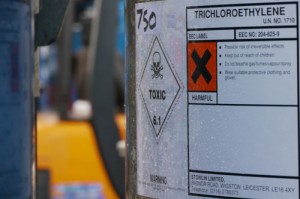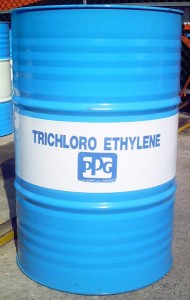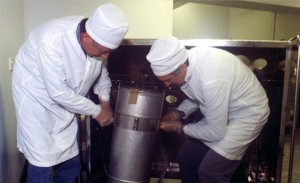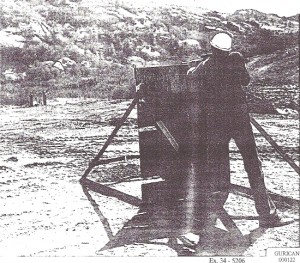 SSFL contamination is also made up of some very nasty chemicals including some that have contaminated soil and groundwater as well as emit toxic gas from the ground and water.
SSFL contamination is also made up of some very nasty chemicals including some that have contaminated soil and groundwater as well as emit toxic gas from the ground and water.
One of these chemicals is trichloroethylene, or TCE, which is a solvent and degreaser. Over 1.73 million gallons of TCE were used at Rocketdyne to hose down the inside and outside of rocket engines after the tens of thousands of rocket tests that were fired at the lab.
Until 1964, this solvent was allowed to sluice into the ground where it contaminates the water today. Half a million gallons of TCE are estimated to contaminate the groundwater at the site, and some of the contamination has migrated offsite. TCE is toxic at miniscule concentrations–its permissible concentration in water is 5 parts per billion. DTSC data from 2004 shows SSFL groundwater containing up to 79,000 parts per billion (ppb) of TCE, 15,800 times the EPA’s “maximum contaminant level†of 5 ppb.
Boeing used to have a system of “air-stripping†towers that would clean the water of 10 gallons of TCE a year, meaning that it would have taken 50,000 years to clean the water.
The off lab property well with the highest TCE concentrations found in a 2004 DTSC report was several hundred yards away from the entrance to SSFL. The RD-38 had a TCE reading of 690 ppb in 2003.
TCE soil concentrations at the site are also extremely high. At the Alfa rocket test stand, TCE was found at 1,820,000 ppb in the soil, 34,340 times the ‘preliminary remediation goal’ of 53 ppb for dirt.
Dioxins are among the most toxic chemicals known and are dangerous at extremely small concentrations.
There were so many dangerous chemicals used at Rocketdyne that it is hard to list them all. One of the worst, though, was monomethylhydrazine (MMH), used as a rocket-fuel propellant at the lab in very large quantities.
The Center for Disease Control says that MMH is a potential human carcinogen which enters the body through inhalation, ingestion, skin or eye contact. The highly reactive reducing agent is prone to fires, explosions and “may ignite spontaneously when spread on a large surface or when in air and in contact with porous materials such as soil, asbestos, wood or cloth or with oxidants such as hydrogen peroxide or nitric acid.â€
MMH was found to be carcinogenic in lab animals. The workers at Rocketdyne who were exposed to hydrazine from the rocket test stands had elevated rates of dying from cancer than Rocketdyne workers with lower exposures, as found in an April 1999 UCLA study. The comprehensive report found that Rocketdyne workers who had high MMH exposures were about twice as likely as other SSFL workers to die from lung and other cancers.
Excessive deaths from cancers of the bladder, blood kidney and lymphatic system were also observed, as well as lung cancers. The chances of dying from one of these cancers were also highest among those who worked in the high-exposure positions during the 1960s, when Rocketdyne’s use of MMH was at its peak. But considering the various amounts of different types of toxic chemicals used on the test-stands, UCLA couldn’t determine absolutely that MMH was the cancer culprit rather than some other toxic material at the site.
No introduction to chemical pollution at Boeing’s Santa Susana Field Laboratory would be complete without including perchlorate, a rocket fuel oxidizer used extensively at Rocketdyne. As a result, perchlorate has contaminated both soil and water on site and apparently off site as well. A significant number of monitoring wells, as well as two supply wells, have had perchlorate detected in them.
Perchlorate interferes with thyroid function and is especially dangerous to fetuses, babies, and children. The white powder, also found in fireworks and road flares, causes thyroid iodine deficiency that in turn limits the gland’s ability to produce a hormone essential to neurological development. “On average, children of iodine-deficient mothers have 5-to-13 fewer IQ points compared to children of mothers with iodine-sufficient diets,†according to a 2005 report by the Environment California Research and Policy Center. “Reduced thyroid levels in the first few weeks of life for pre-term and low birth-weight babies are associated with increased risk of neurological disorders, including the need for special education by age nine.â€
These three toxic chemicals, out of thousands used at Rocketdyne, illustrate the problems the community has had in getting the Responsible Parties (responsible for the pollution, that is), to clean up the Santa Susana Field Laboratory. Each contaminant, in its own way, also illustrates the lengths that the RP’s will go to abscond from their responsibility to clean up their deadly mess.
No, the problem hasn’t been solved. Not by a long shot. Now, the company is suing the State of California, you and me (if you live in the Golden State), to get out of the cleanup obligations it had previously agreed to.
That’s why the Rocketdyne Cleanup Coalition has been in active existence since 1989 and has accomplished such great deeds in the face of seemingly overwhelmingly powerful forces. And if it takes 21 more years to get this cleanup job done right, we will be there to do just that.
But it sure won’t be easy. The toxic legacy of Rocketdyne has left a trail of documentary proof of the need to clean up Rocketdyne. Indeed, dozens of hazardous wastes have been burned over the decades which are documented in Witches’ Brew of Toxic Chemicals Burned by Rocketdyne in Open Pits. This 5.6 mb, 184 page PDF listing some of the toxic chemicals burned in open air pits at the site is required reading for understanding the severity of the chemical contamination caused by Rocketdyne with little or no regard for the communities around the giant site.

